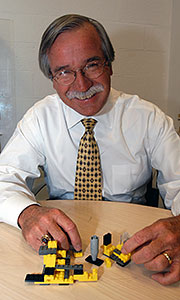Clicking together a small, safe nuclear power plant
A user-friendly design
To make his plan work, Kadak adapted the pebble-bed design. He split the power plant up into modules, each of which fits inside an identical rectangular metal “space frame.” To accommodate shipping by truck or rail, he limited the dimensions and weight of each module. And he arranged the contents of each one so that attaching it to its neighbors—linking wires, piping, tubing, and so on—would be easy.
Kadak put together a step-by-step plan for manufacturing the modules; preparing the building site; transporting the modules; and positioning, aligning, and interconnecting them. Analyses confirmed that the plan is technically feasible and would result in significant savings over traditional methods.
In addition, the plants are user-friendly. Almost all of the modules are accessible from the plant exterior, so they can be removed and replaced with new ones if necessary.
Kadak’s concept may turn out to be ideal for China and other countries that seek to build small plants to serve growing populations in remote locations. Another potential use is for getting oil out of tar sands—an operation generally performed using heat from burning natural gas. Students in one of Kadak’s design classes have studied this option in detail. Given the enormous deposits of oil in tar sands in remote locations, energy companies could be extremely interested. “You never know. You might see oil companies building the next nuclear power plants,” Kadak said.


